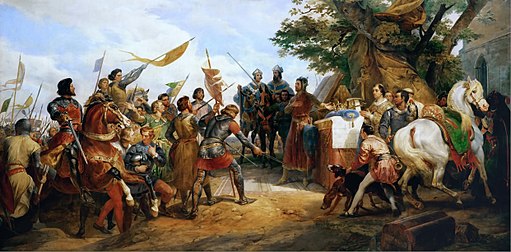Late Capetians
The history of France between 1180 and 1328
The late direct Capetian kings were considerably more powerful and influential than the earliest ones. While Philip I could hardly control his Parisian barons, Philip IV could dictate popes and emperors. The late Capetians, although they often ruled for a shorter time than their earlier peers, were often much more influential. This period also saw the rise of a complex system of international alliances and conflicts opposing, through dynasties, Kings of France and England and Holy Roman Emperor.
Philip II Augustus
The reign of Philip II Augustus (1179–1223) marked an important step in the history of French monarchy. His reign saw the French royal domain and influence greatly expanded. He set the context for the rise of power to much more powerful monarchs like Saint Louis and Philip the Fair.
After a twelve-year struggle with the Plantagenet dynasty in the Anglo-French War of 1202–14, Philip broke up the large Angevin Empire presided over by the crown of England and defeated a coalition of his rivals (German, Flemish and English) at the Battle of Bouvines in 1214. This victory would have a lasting impact on western European politics: the authority of the French king became unchallenged, while the English King John was forced by his barons to sign Magna Carta and deal with a rebellion against him aided by Philip, the First Barons' War. The military actions surrounding the Albigensian Crusade helped prepare the expansion of France southward. Philip did not participate directly in these actions, but he allowed his vassals and knights to help carry it out.
Saint Louis
France became a truly centralised kingdom under Louis IX (reigned 1226–70). Saint Louis has often been portrayed as a one-dimensional character, a flawless representant of the faith and an administrative reformer who cared for the governed ones. However, his reign was far from perfect for everyone: he made unsuccessful crusades, his expanding administrations raised opposition, and he burned Jewish books at the Pope's urging. It appears Louis had a strong sense of justice and always wanted to judge people himself before applying any sentence.
Louis IX was only twelve years old when he became King of France. His mother — Blanche of Castile — was the effective power as regent. Her authority was strongly opposed by the French barons yet she maintained her position until Louis was old enough to rule by himself.
The kingdom was vulnerable: war was still going on in the County of Toulouse, and the royal army was occupied fighting resistance in Languedoc. Count Raymond VII of Toulouse finally signed the Treaty of Paris in 1229, in which he retained much of his lands for life, but his daughter, married to Count Alfonso of Poitou, produced him no heir and so the County of Toulouse went to the King of France.
King Henry III of England had not yet recognized the Capetian overlordship over Aquitaine and still hoped to recover Normandy and Anjou and reform the Angevin Empire. He landed in 1230 at Saint-Malo with a massive force. Henry III's allies in Brittany and Normandy fell down because they did not dare fight their king, who led the counterstrike himself. This evolved into the Saintonge War (1242).
Ultimately, Henry III was defeated and had to recognise Louis IX's overlordship, although the King of France did not seize Aquitaine from Henry III. Louis IX was now the most important landowner of France, adding to his royal title. There were some opposition to his rule in Normandy, yet it proved remarkably easy to rule, especially compared to the County of Toulouse which had been brutally conquered. The Conseil du Roi, which would evolve into the Parlement, was founded in these times.
Saint Louis also supported new forms of art such as Gothic architecture; his Sainte-Chapelle became a very famous gothic building. The Kingdom was involved in two crusades under Saint Louis: the Seventh Crusade and the Eighth Crusade. Both proved to be complete failures for the French King.
Philip III and Philip IV
Philip III became king when Saint Louis died in 1270 during the Eighth Crusade. Philip III was called "the Bold" on the basis of his abilities in combat and on horseback, and not because of his character or ruling abilities. Philip III took part in another crusading disaster: the Aragonese Crusade, which cost him his life in 1285.
More administrative reforms were made by Philip IV, also called Philip the Fair (reigned 1285–1314). This king was responsible for the end of the Knights Templar, signed the Auld Alliance, and established the Parlement of Paris. Philip IV was so powerful that he could name popes and emperors, unlike the early Capetians. The papacy was moved to Avignon and all the contemporary popes were French, such as Philip IV's puppet Bertrand de Goth, Pope Clement V.
References: Wikipedia

